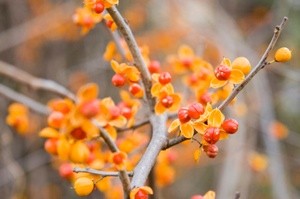
Bittersweet is an easy-to-grow vine famous for revealing a striking display of seedpods and berries each fall. Often used in wreaths or decorative displays, this ornamental vine adds value and interest to the garden all year long. Here is everything you need to know to grow this hardy American native.
American Bittersweet:
American bittersweet (Celastrus scandens) is a deciduous, perennial vine native to North America. Often found growing over fences or climbing up trees, their typical habitat includes rocky upland woodlands, savannas, thickets, and along shady riverbanks of the central and eastern U.S. American bittersweet has smooth, 2 to 4 inch long green leaves. The vines produce tiny greenish-white flowers in June and in early fall, orange-yellow seed husks peel back to reveal scarlet-colored fruit.
Bittersweet fruits are not safe for human consumption, but when left on the vine, they provide a much appreciated source of late winter food for many birds and small animals.
Chinese Bittersweet:
Unlike its American counterpart, Chinese (Oriental) bittersweet ( Celastrus orbiculatus), is considered an invasive plant in most areas. It can easily climb to heights of 40 ft or more in its quest to strangle nearby trees. Like American bittersweet, Chinese bittersweet is often used for fall decorating. The two would be easily confused if were not for the fact that the young twining shoots of Chinese bittersweet come equipped with a pair of soft thorns and its seed casings are yellow instead of orange.
Fall is a good time to plant bittersweet. If mulched and protected over winter during its first year, bittersweet will remain maintenance free for most of its long life. To get the vine to produce brightly colored berries, you will need to plant both sexes of the vine within close proximity of one another. When purchasing plants from a nursery, be sure the sex of the vines are properly identified. The female vines produce the berries, but the sexes are impossible to tell apart until the plants are mature. One male plant will easily produce enough pollen for 6 to 8 female plants (bees are the main pollinators).
Bittersweet can be bought from a nursery or propagated from seeds or cuttings. Seeds sown in the spring need to be placed in containers of moist sand or peat and kept in the refrigerator (34 to 41 degrees F) for 3 months to break dormancy.
Bittersweet vines grow well in both full sun and shade, although full sun is critical for fruit production. These vines are not particularly fussy about soil quality and pests seldom bother them. Because of their climbing habit, bittersweet needs a sturdy support-either an upright trellis or a lateral fence. Do not let it climb up a tree, however, because the twining nature of these vines will easily girdle the trunk. Occasional light pruning will keep plants tidy and help reign in their size. Pruning can be done in late winter or early spring.
Bittersweet is ready to harvest when you see the first orange capsules of the fruit split open to reveal the orange-red fruit inside. Cut stems to then length you desire and tie them into small bundles. Hang the bundles to dry in a warm, dark room. As the fruit dries, more unopened capsules will split open to reveal the fruits inside. Once dried, the vines make an attractive botanical display that will last for several years.
Cutting back invasive bittersweet plants can stimulate the growth of new stems and root suckers. To kill a mature plant, cut back all top growth, and dig out the stump, making sure you get all remaining pieces of the roots. If necessary, repeat this procedure again in the late summer if new shoots spring up from the old roots.
Bittersweet readily self-sows, so when left unchecked, plants can soon be seen popping up everywhere. If you see plants sprouting where you don't want them, pull them out or relocate them to another part of the garden.
The seeds of more invasive Chinese bittersweet are spread by birds and animals and can remain viable for several years. Pulling parent plants out before they go to seed will assist greatly in eliminating the growth of future plants.

Add your voice! Click below to comment. ThriftyFun is powered by your wisdom!
Don't plant bittersweet! It get's out of control quickly and will look to climb on anything. I have had trees entirely engulfed in the vine and the vine eventually strangles the tree.
American bittersweet will NOT KILL trees, period. It is in danger of being lost in the native landscape and is often protected by law. The bad one is oriental bittersweet (a non-native invasive), it will kill trees as it wraps around them and girdles sap flow. Learn them so you know (clumps of fruit at the end on American sort of like grapes). It is an important bird and wildlife food in winter. Humans should not eat the fruit. Please protect the American Bittersweet vine.
I transplanted my bitter sweet last year , but the berry where very tiny , do i need to move it again , it is in the morning sun.
Add your voice! Click below to comment. ThriftyFun is powered by your wisdom!